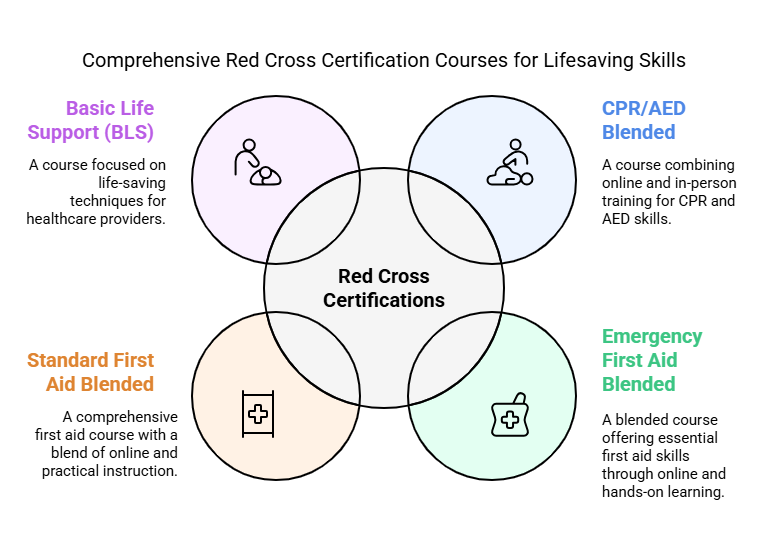
Red Cross Certifications: How to Get Certified & Why It Matters
Are you the one seeking to gain knowledge to equip yourself with the skills to help save a life? Or are you looking for jobs in healthcare? Or is getting Red Cross Certifications your workplace requirement? If the answer to any of these questions is yes, then you have landed in the right place.
Red Cross Certifications is the answer to your needs. These courses add up to anyone’s life skills for survival. These certifications will help people save lives at their workplace, of their family members, friends, and the public. And the best part? These training modules and certifications are valid and relevant globally.
The Canadian Red Cross offers these certifications to train volunteers for emergency assistance and disaster response. It is a charitable organization that promotes prevention services such as safety and first aid training to support the world’s vulnerable populations during war and peace.
There are various kinds of Canadian Red Cross Certifications. You can choose them according to your needs or professional requirements. Read this post to understand different certificate courses, how they benefit, and the steps to get certified.
Red Cross Certifications: Courses Explained
Being certified is important in Canada. Because of these, you gain knowledge, skills, and experience to be a professional lifesaver. Let us now walk through the details of the different certificate courses.

CPR/AED Blended
The CPR first aid certification course teaches you the CPR (Cardiopulmonary Resuscitation) techniques followed to recover someone’s breathing or heartbeat when it has stopped. CPR AED Certification provides you with the knowledge and practical skills to be able to perform cardiopulmonary resuscitation (CPR) and use an automated external defibrillator (AED).
With this Red Cross CPR certification, you will be equipped to recognize and respond to cardiovascular emergencies and choking in adults, children, and babies, depending on the level of CPR learned.
Course Outcome:
The Level A CPR AED Course covers the following modules:
- The Red Cross
- Check, Call, Care
- Responding to Emergencies
- Choking: Adults
- Assisting with medications
- Angina and Heart Attack
- Stroke
- AED use: Adults
- Deadly Bleeding
Along with all that is covered in Level A, Level C covers the following:
- Choking: Child and Baby
- CPR and AED: Child and Baby
Emergency First Aid Blended
The Blended Emergency First Aid Course teaches you how to provide basic, immediate, and urgent aid to the injured in any emergency scenario. It is a complete training that will cover first aid and CPR skills so you can save lives at home, at work, and in public areas.
Course Outcome:
You will gain knowledge about the following concepts:
- The Red Cross
- Preparing to Respond
- The EMS (Emergency Medical System)
- Check, Call, Care
- Airway Emergencies
- Breathing and Circulation Emergencies
- Wound Care
- First aid for respiratory and cardiac arrest
Standard First Aid Blended
The blended standard first aid course includes everything from Emergency First Aid and is intended for those who need a more in-depth grasp of first aid. This first aid certificate benefits those who require training for work or want to learn more about responding to emergencies at home.
Course Outcome:
The standard first aid blended certification course will teach you the following modules:
- The Red Cross
- Preparing to Respond
- Airway Emergencies
- Breathing and Circulation Emergencies
- The EMS System
- Check, Call, Care
- First aid for respiratory and cardiac arrest
- Bone, Muscle, and Joint Injuries
- Environmental Illnesses
- Wound Care
- Sudden Medical Emergencies
- Poisons
Basic Life Support (BLS)
The goal of the Red Cross Basic Life Support Certification is to increase participants’ confidence in their ability to execute cardiopulmonary resuscitation (CPR) techniques in a team setting for professionals who are on duty to respond.
The course covers the essential processes for performing a rapid evaluation, Basic Life Support skills, and rapid defibrillation, which includes the use of an Automated External Defibrillator (AED).
Course Outcome:
This BLS certification offers you value in the form of:
- Primary Assessment
- Glove Removal
- Cardiopulmonary Resuscitation (CPR) and Automated External Defibrillator (AED)
- Airway Obstruction
- Assisted Ventilation
- Basic Life Support Special Considerations
This course can also be completed with extra certifications in airway management and oxygen therapy.
Highlights of Certification Courses
The highlights of the different certification programs are:

-
Different CPR Levels: You can choose from the different CPR levels available. With level A, you can learn the techniques to save the lives of adults, while level C is for all age groups (infants, children, and adults).
-
Certificate Validity: The first aid and CPR course is valid for 3 years, while BLS is a 1-year certification. These certifications can be renewed with recertification courses.
- Blended Format: The courses are offered in a blended format, which means you take theoretical online classes, and after their completion, you can take in-class practical sessions.
Canadian Red Cross Certificate Benefits
Red Cross Certifications open various opportunities and elevate the level and quality of your skills. Being certified benefits individuals in the following ways:

Live-Saving Skills
Being certified opens multiple doors of job opportunities for you. Students receive ample opportunities as coaches, lifeguards, flight attendants, security guards, and fitness trainers in the field of sports and recreation.
Skill Enhancement
These certifications upgrade the standard and quality of your expertise. Learners acquire the expertise, knowledge, and experience necessary to respond effectively to medical and healthcare emergencies such as heart attacks, accidents, injuries, and others to help secure public safety.
Professional Requirement
It is a requirement for those who wish to become professional healthcare, childcare, and elder care professionals. Individuals are trained to offer CPR, first aid, and emergency care.
Credibility
The Red Cross emergency response training extends credibility to your knowledge, abilities, and experiences. You have an advantage in being recruited because you earned your certification/recertification from a reputable Canadian institute/college/university.
Personal Development
Being certified boosts your personality and confidence. The rate of your personal skill improvement accelerates. You feel confident while responding to any emergency.
How to Get Red Cross Certified?
ActiCert, in partnership with the Canadian Red Cross, aspires to provide a safe and supportive environment. ActiCert conducts all the above-mentioned Red Cross . Through the aid of our effective teaching personnel at various locations in Canada, ActiCert looks forward to reaching out to individuals and companies to advance the comprehensive agenda of safety and well-being.
Follow these simple steps to get certified:

Choose from any Certification Course
Go through the details of each program at ActiCert’s official website (https://acticert.com/redcross/). Select the certificate course that best suits your requirements.
Complete the Registration Process
Once you have selected the course, register on the website and pay the fees online. Here’s a quick link for you: https://acticert.com/red-cross-certification-registration/.
Take the Assessment Test
After taking the online theoretical classes and in-person practical sessions, complete the evaluation. Along with a written multiple-choice test, participants are assessed on their proficiency in first aid and CPR during the course.
Print Certificate
You get your official certification card three to four business days following your training. Receive your certificate digitally; print or save it. You are now ready to work with your new credentials!
People Also Ask (FAQs)
Where does ActiCert provide the Red Cross Certifications?
Acticert offers CPR and first aid training at various locations across Brampton, Mississauga, North York, Ottawa, and Windsor.
What are the program requirements to get Red Cross certified?
To get certified, complete online learning before attending an in-person skills session. You should be able to demonstrate skills and critical steps with a minimum 75% mark for the written knowledge evaluation. Moreover, you should attend and participate in 100% of the course
Who can take these certification courses?
Anyone can enroll in ActiCert’s certification courses. However, individuals who have pre-existing medical issues, such as pregnancy, bone, muscle, joint, or respiratory disorders, should see a doctor before attending.
Which Canadian Red Cross Certification should I choose?
The choice comes down to career goals and personal interests. If you are in healthcare or work as a first responder, then BLS is the best choice. On the other hand, take a CPR AED, emergency, or standard first aid course to help save a life at home, workplace, and in public places. However, if it is a requirement at your workplace, then you should choose the course accordingly.
Final Thoughts
Red Cross certifications are extremely beneficial to everyone. Such a course assists both patients and professional first-aid workers. ActiCert offers all these Red Cross certifications for you.
We offer training and certificates to students, professionals, and immigrants seeking to develop and advance their careers. Our trainers are highly trained and seasoned industry professionals with a diverse range of knowledge and teaching abilities.
Enroll now with ActiCert and experience this yourself! If you have any questions or need assistance, call +1 (905) 487 7043 or email lifeline@acticert.com. We are here to help you!